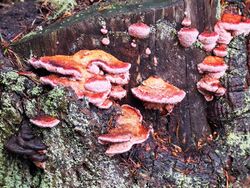Biology:Rhodofomes cajanderi
| Rhodofomes cajanderi | |
|---|---|

| |
| Scientific classification | |
| Domain: | Eukaryota |
| Kingdom: | Fungi |
| Division: | Basidiomycota |
| Class: | Agaricomycetes |
| Order: | Polyporales |
| Genus: | Rhodofomes |
| Species: | R. cajanderi
|
| Binomial name | |
| Rhodofomes cajanderi (P.Karst.) B.K. Cui, M.L. Han & Y.C. Dai (2016)
| |
| Synonyms | |
|
List
| |
Rhodofomes cajanderi is a widely distributed species of bracket fungus. Commonly known as the rosy conk due to its rose-colored pore surface, it causes a disease called a brown pocket rot in various conifer species.[1] It is inedible.[2] It is widespread in western North America, with more prevalence in southern climates.[1] It has a particular preference for higher-altitude spruce forests.[1]
Identification
Rhodofomes cajanderi is a perennial shelf fungus.[1] It may be identified by its small-to-medium-sized, fleshy, tough fruit-body, with a downy or crust-like top.[3] It grows to around 3–10 cm (1.2–3.9 in) wide.[4] The top surface is a pink colour becoming to grey, brown, or black, with a clear margin.[1] The inside of the conk and the bottom are a rosy pink colour.[1] The body of the fungus is rigid and can grow up to 1 cm thick.[1] There are 3–5 round pores per millimeter.[1]
This species of polypore is morphologically similar to its relative, Rhodofomes roseus. Other similar species include Fomitopsis pinicola, Ganoderma lucidum, Ganoderma oregonense, and Rhodonia placenta.[4]
See also
References
- ↑ 1.0 1.1 1.2 1.3 1.4 1.5 1.6 1.7 Ginns, J. H. (James Herbert) (2017). Polypores of British Columbia (Fungi: Basidiomycota). Victoria, BC. ISBN 978-0-7726-7053-3. OCLC 982126526. https://www.worldcat.org/oclc/982126526.
- ↑ Phillips, Roger (2010). Mushrooms and Other Fungi of North America. Buffalo, NY: Firefly Books. p. 309. ISBN 978-1-55407-651-2.
- ↑ Watling, Roy. (1973). Identification of the larger fungi. Amersham: Hulton. ISBN 0-7175-0595-2. OCLC 1200490.
- ↑ 4.0 4.1 Davis, R. Michael; Sommer, Robert; Menge, John A. (2012). Field Guide to Mushrooms of Western North America. Berkeley: University of California Press. pp. 346–347. ISBN 978-0-520-95360-4. OCLC 797915861. https://www.worldcat.org/oclc/797915861.
Wikidata ☰ Q104083859 entry
 |

